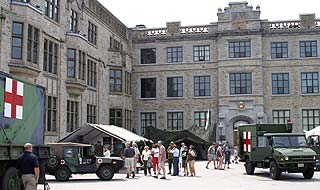The Story of the Canadian Forces Health Services
The Canadian War Museum 2004 Summer Exhibition, June 29 to September 6,
2004
Text Size : Standard -
Larger

Critical Care Courtyard exhibition with the Canadian Forces
This year marks the centennial of the Canadian Forces Health
Services (CFHS), the medical branch of the Canadian Forces. The
exhibition Critical Care: On the Battlefield and Around the
World tells the story of Canadian military medical personnel,
including dentists, doctors, nurses, and other health services
professionals, who operate behind the scenes but play a vital role in
successful military operations. The exhibition presents a 100-year
perspective on the human experience and accomplishments of these people in
peace and war, in Canada, and overseas.
"The motto of the Canadian Forces Medical Services is
'militia succurimus' which means 'we hasten to support the
soldier'. This exhibition will demonstrate how the men and women of the
Canadian Forces Medical Services, and the Canadian Forces Health
Services, have lived up to this noble calling throughout our
history," said Col. Scott Cameron, CF Surgeon General.
The Canadian War Museum exhibition Critical Care
consists of two related
components: the General Motors Courtyard focuses on today's operations
Around the World, and the Third Floor Gallery features
a historical look at military medicine On the Battlefield.
Survival rate of Canadian wounded who reached
care :
First World War: 89%
Second World War :94%
Korean War: 97%
Critical Care Around the World: General Motors Courtyard
During the months of July and August, the Canadian Forces Health
Services will present a variety of different exhibitions. The
displays will be staffed by currently serving personnel, who will talk to
visitors about their recent experiences and explain the use of their
equipment:
Battlefield Medicine: June 29 - August 2
Canadian Forces Health
Services field personnel will host an exhibition
focused on battlefield medicine, which showcases a mobile Unit Medical
Station, a Light Support Vehicle Wheeled ambulance, and an armoured
Bison ambulance.

Dental Services truck-mounted mobile clinic
Dental Services: July 20 - August 14 (in addition to Battlefield
Medicine)
Visit the dentist! Canadian Forces Health Services dental
services will
showcase their equipment. A truck-mounted mobile dental clinic, the
Dental Special Equipment Vehicle, is a fully functional dental operatory
capable of treating all but the most serious cases.
Field Hospital: August 4 - September 6 (in addition to Dental
Services)
In August, the Courtyard exhibition will focus on the field hospital
support capabilities of all three branches of the Canadian Forces. Inspect
aeromedical evacuation equipment; learn about aviation medicine, and how
patients are transported. The exhibition will also include a mobile
operating room, resuscitation bay, intensive care ward and critical
care ward.
Critical Care On the Battlefield: Canadian War Museum Third Floor
Gallery
In this gallery, you will learn about
Canadian military medicine
through the course of three major high intensity conflicts of the last
century - the First and Second World Wars, and the Korean War. A
chronological exhibition of photographs and artworks, from the National
Archives, the Canadian War Museum Photo Collection and the Canadian War
Museum's Beaverbrook Collection of War Art, will demonstrate how medical
services cared for the wounded in all three conflicts. It will show that
while the process remained essentially the same in all three conflicts,
there were also critical improvements that advanced survival rates. You
will see images of medics at work on the battlefield, ambulances
transporting wounded to care, special surgical teams and nursing sisters
at work, and soldiers recuperating well behind the lines.
Effective military medicine depends on the seamless integration of
facilities and highly-trained medical professionals under demanding
conditions. Via a network of facilities including Forward Aid Posts and
Field Hospitals, Casualty Clearing Stations, and General Hospitals, the
people who operate behind the scenes play a vital role in making military
and peacekeeping operations successful. Over the years, this system has
enabled the vast majority of Canadian wounded who reach care to survive:
89% in the First World War, 94% in the Second World War, and 97% in the
Korean War. Casualty survival rates increased due to advances in medical
technology, such as the introduction of immediate blood transfusion in the
Second World War, and achieve faster evacuation times in the Korean War.
The exhibition will give you a sense of the stressful and dramatic
conditions under which medical personnel worked, the nature of the methods
by which the wounded were cared for, and some insight into the nature of
the care they received. Important distinctions between the eras will be
explained by the accompanying text. The exhibition also includes a
bilingual touch-screen video station, which will present a brief overview
of Canadian military medicine, developed by the Department of National
Defence.
Canadian military medicine was, and remains, an important presence in
all Canadian military operations and has been a key factor in mitigating
the death and suffering that are an inevitable component of conflict.